

The Non-Fiction Collection - Once Upon a Picture. Game of English Language Teaching. How to Write a Summary of an Article. Virginia has been a university English instructor for over 20 years.
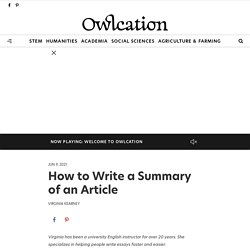
She specializes in helping people write essays faster and easier. When Should You Summarize an Article? To show how an author's ideas support your argumentTo argue against the author's ideasTo condense a lot of information into a small spaceTo increase your understanding of an article What is a Summary? A great summary is easy to read and explains all of the main points in the original. The main idea of the article is conveyed clearly and conciselyThe summary is written in the unique style of the writerThe summary is much shorter than the original documentThe summary explains all of the important notions and argumentsThe summary condenses a lot of information into a small space How Do You Summarize an Article?
Summarizing an article can be boiled down to three simple steps. Identify the main idea or topic.Identify important arguments.Write your summary. Sense of progress 10 of 10: putting it all together. An important caveat: what follows is a blog post, not particularly serious or academic – just my own practical take on progress and on how to make it more obvious in the classroom.
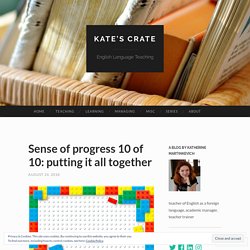
It’s a synthesis of all the previous posts in the series and the sources they contain, and I’m making loads of assumptions and generalisations here! There’s research supporting some of the ideas, but none of them will work with all learners all the time, so feel free to experiment and let me know what has worked for you. Why is the sense of progress so important? Because it’s directly related to student satisfaction. It’s human psychology: when we feel we’re making progress, the sense of accomplishment releases dopamine, which affects our emotions, perceptions and motivation. 101 Ways to Use a Long Video in the Classroom – Kamila of Prague. My one-to-one student has recently become interested in the topic of unschooling and asked me if we could do this video on the topic in our English class.
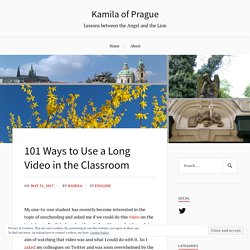
Working with Long Videos - Anthony Teacher.com. Recently on Twitter there was a nice little thread prompted by Kamila Linková, asking for suggestions on what to do with a long (10 minute) video: And there were a flurry of responses – so many that she wrote this great post entitled “101 Ways to Use a Long Video in the Classroom.”

Last term, long lectures were the staple of my content-based US history/advanced speaking and listening course. In that course, the lectures came from a popular lecture series and were 30 minutes each. Language learning habits: how to achieve more by trying less. Imagine a man who does 70 push-ups a day.

What kind of person comes to mind? An intense overachiever with willpower as strong as his biceps? Songs Archives - Picnic English. Fun discussion of controversial topics - the 'Tap-In Debate' Basically, you need a controversial topic to start.

Once you have established a controversial topic, divide your students into two groups; those who agree with the statement and those who disagree. They now prepare their arguments. Once you have done this, arrange your chairs so that there are two hot seats facing each other and then place chairs behind each of the two hot seats (enough for all of your students). The idea is that two students start the topic of conversation, trying to defend their group's point of view.
Once started, you then tap any two students on their shoulders during the conversation (Always one who is in a hot seat and one who isn't) Once they have been tapped on the shoulder they MUST stop the conversation and two new students must resume it exactly where the other two left it, even if this is in mid sentence (they change places with the person in the hot seat).
Get Debating. Description Get Debating is a new series of classroom worksheets focusing on debating techniques, structuring effective arguments and finding suitable topics for debate.

The pack consists of four worksheets that students can use in the classroom, as well as a glossary of debating terms and accompanying teachers' notes. The four worksheets are: Debater’s Checklist - A step by step checklist to get students ready for debate. Sense of progress 9.5 of 10: vox pop results. Ok, I’ve cheated a bit: the Hofstadter’s Law is affecting not only the time I need for the Sense of Progress series, but also the number of posts!

Apparently, this is not the last one. I have had ten respondents on social media so far (thank you all!) : not exactly ‘big data’, but very interesting results nonetheless. So: when we think about our own progress, most people look back and try to compare their present achievements with the past. The 25 best icebreaker questions for team-building at work. If you winced at the word, “icebreaker,” I don’t blame you. Get-to-know-you questions and games tend to feel cheesy. We’ve all been victim to a terribly trite icebreaker with coworkers that made us roll our eyes. I know I have. Playing with PlayPhrase - Anthony Teacher.com. When I first learned of PlayPhrase several years ago, I was quite excited about its pedagogic potential, even though I didn’t know exactly what that potential was.
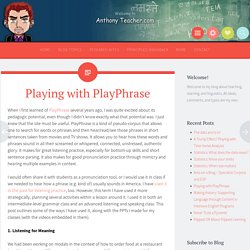
I just knew that the site must be useful. PlayPhrase is a kind of pseudo-corpus that allows one to search for words or phrases and then hear/read/see those phrases in short sentences taken from movies and TV shows. It allows you to hear how these words and phrases sound in all their screamed or whispered, connected, unstressed, authentic glory. Starter Teachers: A methodology course for the classroom.
Pronunciation priorities. Uh-oh!
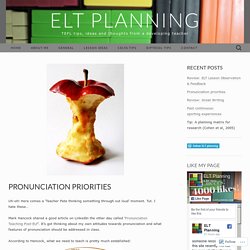
Here comes a ‘Teacher Pete thinking something through out loud’ moment. Tut. Post ELF. Ltskills18. A lesson, focused on character description, using an excellent app. I recently did a lesson which had a focus on character description. For my starting point, I used the short film, ‘Junk’. You can find the video below (thank you to The Literacy Shed for finding this great resource): Next, I asked the students to describe the character Jasper to their talk partners. After this, I handed out a silhouette which I had sketched of Jasper, and the pupils had to put sentences about his appearance on the outside and personality on the inside (see below for an example). I put emphasis on including relative clauses to deepen/expand the description (using which or that). Finally, the students had to write some quick notes and then perform a descriptive account in the first person; using the app Tellagami.
Have a look at my tutorial, telling you everything you need to know about this fantastic tech tool: Here are some examples of the outcomes of the task: *Here is the presentation I created for the lesson (feel free to make a copy / download): Classroom resources for teachers. Twinkl Search. Greatest Tearjerkers - Scenes and Moments. Story Starters: Creative Writing Prompts for Kids.
Writing. TED4ESL – Your place for ESL materials – ESL worksheets and lesson plans based on TED Talks. Films in ESL. SPEAKING:DISCUSSION TOPICS. Lesson plans. Functional language. TeachingGamesEFL.com – by Mike Astbury. Quiz: a week in 12 questions + caption competition. BusyTeacher.org. YouTube, as well as websites such as wikihow.com, instructables.com, and soyouwanna.com, have an incredible assortment of guides on how to do almost anything, from cutting up onions to making paper airplanes. In this article, I’m going to explain how to adapt a video tutorial into a listening lesson for your ESL/EFL classes.
How-to videos contain a number of features which makes them perfect for exploitation in the ESL/EFL classroom: authentic English with natural pronunciation content that relates to everyday life a wide range of topics that can be used images and (in some cases) titles and subtitles which make the meaning clearer the pleasure of learning a useful skill and new English vocabulary at the same time. Film Club - The New York Times. ESL Games For Adult Classes - Easy ESL Games. ESL discussion material based on TED talks. Famous People English Lessons: Biographies and ESL Lesson Plans. Tim's Free English Lesson Plans – Use them, share them, comment on them, and share my link in return.
A NEW LANGUAGE MEANS ANOTHER VISION OF LIFE. Free Inspirational Movie Clips for Teaching and Sermon Video Illustrations at WingClips.com. Video Lesson Plans for Teachers. Viral Videos for Higher Level ELT. By Kieran Donaghy.